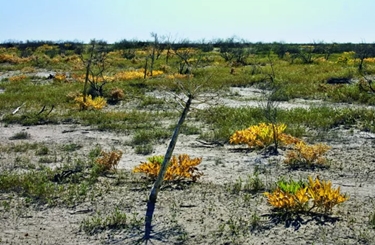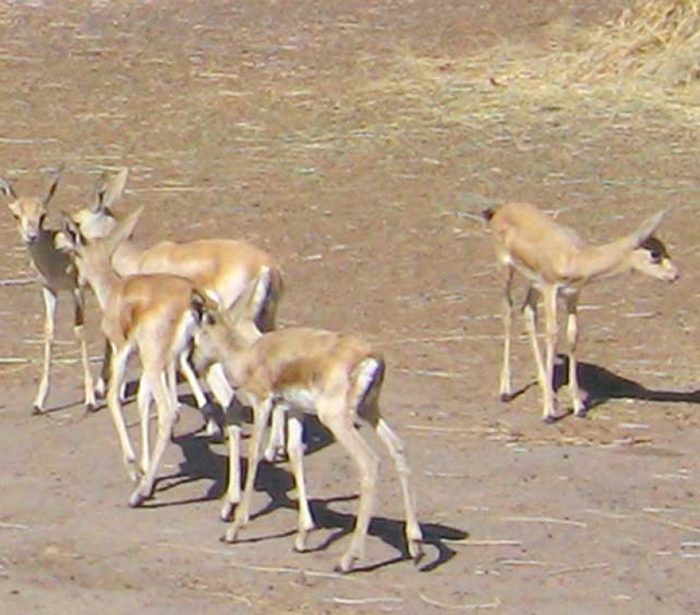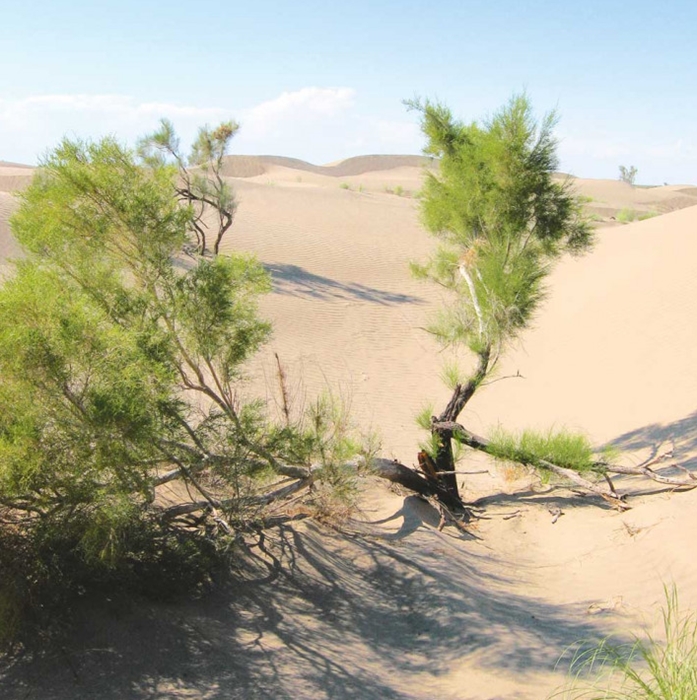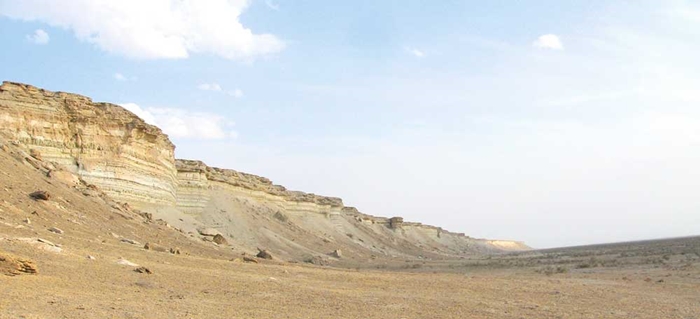Arazmyrat Amanov, Head of the Scientific Department of the Kaplankyr Reserve of the Ministry of Environmental Protection of Turkmenistan
In 1979, the Kaplankyr State Nature Reserve, run by the Ministry of Environmental Protection of Turkmenistan, was established to protect and restore the number of gazelles, honeyeaters, and Ustyurt mountain sheep. This year, 2024, the reserve celebrates forty-five years since the beginning of scientific activities to study the flora and fauna of the northern part of Turkmenistan. The local ecological systems are famous for the variety of types of natural landscapes, they are the standard of Turkmen nature. Last year the territory of the state reserve was inscribed on the UNESCO World Heritage List as a part of the transnational nomination of Cold Winter Deserts of Turan.
The protected area, covering over 275 thousand hectares, includes the plateau of the same name – the southern spur of Ustyurt and is divided into two sections – Kaplankyr and Kulantakyr. Their names are toponyms, evidence of the habitation of Red book leopard and kulan. According to previous years, a small migratory population of kulan up to forty heads lives within the reserve, the habitat of which includes the territories around Lake Zengibaba, the foot of the Ustyurt kyr, Yedikhovuz, Gulantakyr and Dusheklidash, places near wells.
The Sarykamysh and Shasenem nature reserves operate in the reserve, created to protect waterfowl and near-water wintering, nesting, flying birds, as well as ungulates. In recent years, the main groups of gazelles total at 200 heads. The mountain sheep, or argali are found on the Kaplankyr and Ak inish hills (Southern Ustyurt) in the number of 60-70 heads. Environmentalists are not limited to environmental protection and biodiversity. The are engaged in an annual set of observations called “Chronicle of Nature”. The create plant nurseries and aviaries for local original species of plants and animals, which eventually replenish natural populations. Scientists have the opportunity to study wild flora and fauna, thus maintaining their stability in their natural habitat.
The peculiarity of the local rocky plains, sloping areas of salt marshes suggests the habitation of small vertebrates such as lizards, snakes. Most of the available mammals (insectivorous rodents and bats) are nocturnal, hiding in the daytime heat in burrows and other shelters. Almost all ungulates and other large animals are listed in the Red Book of Turkmenistan as honeyeaters, and among wild cats are the dune cat, manul.
The local vegetation is salt–tolerant halophytes and sand-loving xerophytes. These are low–growing shrubs and semi-shrubs like kandym, cherkez, black saxaul, which prefers saline soil, and white saxaul, growing on fresh sands, where adult trees can reach a height of eight meters. There are endemic species in the reserve, that is, flora species that are not found anywhere else except Kaplankyr, to strengthen their groupings in their usual habitats. Ecologists grow them from seeds in nurseries, observe their vegetation, and look for new places of their growth.
The presence of a chain of lakes connected by reservoirs with a common composition of fish, a rich food base, the presence of high steep chinks inaccessible to predators are excellent conditions for nesting. Therefore, Kaplankyr is an avian “eldorado”, featuring a rich variety of sedentary, migratory, wintering, especially wetland and predatory avifauna species. Here you can follow the flight of a kestrel, a marsh harrier, a steppe eagle, and with the help of powerful optics you can see how rare pink and curly pelicans feed on the islands of Lake Sarykamysh remote from the shore, and seagulls sit on nests.
Unforgettable encounters in the north of Turkmenistan await. Here, you might find yourself face-to-face with the rare gyrfalcon, its piercing gaze surveying the landscape from a rocky crag. Or, during migration seasons, witness a flock of majestic flamingos, their vibrant pink plumage contrasting against the serene Sarykamysh bays. These elegant creatures rise gracefully from the water as you approach, leaving behind a feather, perhaps a pale crimson souvenir of their fleeting visit.
The use of camera traps gives good results. This helps to carry out biodiversity surveys, as well as to find out the permanent habitats of large animals and rare birds, including nocturnal predators like owls and owl. Where active life is found, environmentalists arrange food warehouses for the winter, drill additional watering holes, repair and equip wells so that wild ungulates can have their own watering hole. Various measures are aimed at preserving the number of such animals, including biotechnical measures, monitoring populations in transboundary habitats, and data exchange with neighboring countries. Among the technical measures are the installation of observation towers to ensure maximum coverage of key facilities, effective inspection of the territory during the summer fire season, the prevention of such incidents to preserve the Kaplankyr nature and its inhabitants, large and small.
The nature reserve in the north of Turkmenistan is one of the most extensive protected natural areas of the country, and it will take several days just to go around it with a brief inspection. There is enough space for ungulates to move freely during the migration seasons. There are notable natural sites, hydrological, karst and landscape sites within the reserve and beyond its borders. One of them is a sharp-nosed ridge with steep sides, layers of sandstones and gypsum called “Burçly burun”. Soft rocks eroded by rains and blown by winds, exposed to moving groundwater and chloride salts, the collapse of roofs over underground voids form these sinkholes, funnels, “wells”, “mines”, hollows and depressions, caves and niches. Some of them have preserved traces of ancient settlements, because these were wonderful natural shelters that could have water sources.
Another notable site is the Mergen Ishan gorge, 6-km long, 15 to 70 meters wide and steep walls up to 35 meters high. This is one of the amazing creations of the Great Amu Darya. A powerful water stream of a wayward river once raced along this winding canyon, which often changed its course. According to scientists, the river could reach the Caspian Sea. Now the sandy bottom of the Mergen Ishan gorge, which could have served as an arm of the river or its main channel, is overgrown with combs and shrubby vegetation, including a relict plant like Malococarpus crithmifolius (“Turkmen cranberry”). This small ecosystem has become a center of habitat for birds and small animals, nesting of the owl, partridge, kestrel. Porcupines, badgers hide in burrows in gorge’s folds from the chilling winds. The wolves, wild boars and foxes run in to warm up and for feeding, while reptiles are active in summer.
The Zengi Baba depression, which has filled with water and dried up over its history is the hydro object of the Kaplankyr steppes. Its last watering was associated with the intensive agricultural development of the Shasenem massif in the last century, after which the vast territory of the ancient delta of the Amu Darya River received a powerful incentive to acquire a new hypostasis of ecological balance. Now, during the flight period, flocks of coots, ducks, and cormorants rest on the lake, and the offspring of caracals, porcupines, and honeyeaters hide in the coastal thickets. The water area of the lake is rich in catfish, carp, bream. The man-made Uzynshor Lake and the Turkmen “Altyn Asyr” Lake on the reserve’s western border, form a vital network of freshwater havens, maintaining favorable conditions for the existence of a unique complex of biodiversity of Kaplankyr. ///Originally published by Neutral Turkmenistan newspaper, 29 January 2024



